reset VOLVO XC90 2007 Owners Manual
[x] Cancel search | Manufacturer: VOLVO, Model Year: 2007, Model line: XC90, Model: VOLVO XC90 2007Pages: 268, PDF Size: 8.57 MB
Page 6 of 268

2007 Volvo XC90
driving safely. Distraction can lead to a serious accident.In addition t\
o this general warning, we offer the
following guidance regarding specific newer features that may be found i\
n your vehicle:
l Never use a hand-held cellular telephone while driving. Some jurisdictio\
ns prohibit cellular telephone
use by a driver while the vehicle is moving.
l If your vehicle is equipped with a navigation system, set and make chang\
es to your travel itinerary only
with the vehicle parked.
l Never program your audio system while the vehicle is moving. Program rad\
io presets with the vehicle
parked, and use your programmed presets to make radio use quicker and si\
mpler.
l Never use portable computers or personal digital assistants while the ve\
hicle is moving.
A driver has a responsibility to do everything possible to ensure his or\
her own safety and the safety of
passengers in the vehicle and others sharing the roadway. Avoiding distr\
actions is part of that
responsibility.
pg. 6 Introduction
This page left intentionally blank.
pg. 7 Introduction
Contents
Safety
Instruments and controls
Climate control
Interior
Locks and alarm
Starting and driving
Wheels and tires
Vehicle care
Maintenance
Specifications
file:///K|/ownersdocs/2007/2007_XC90/07xc90_00.htm (6 of 7)12/30/2006 \
5:53:31 PM
Page 50 of 268

2007 Volvo XC90
35. Central locking button45
36. Lockout switch for rear seat power windows
45
37. Power window controls
45
38. Sideview mirror controls
45
pg. 46 Instruments and controls
Instrument panel
1. Turn signal indicators - right/left
2. Text window
The text window displays information and warning messages.
3. Temperature gauge
The pointer should be approximately midway on the gauge when driving. Do not drive the vehicle if
the warning light is on. The text window will provide you with additional information.
If the engine temperature remains high, check coolant level - see
page 184.
4. Trip odometer
The trip odometers are used for measuring shorter distances. The right-h\
and digit gives tenth of a mile/
kilometer. Press the button for more than 2 seconds to reset. Change bet\
ween trip odometers 1 and 2
using one short press on the button.
5. Odometer
6. Speedometer
7. Warning symbol
file:///K|/ownersdocs/2007/2007_XC90/07xc90_02.htm (4 of 40)12/30/2006\
5:53:37 PM
Page 56 of 268

2007 Volvo XC90
SERVICE REQUIRED Take your vehicle to an authorized Volvo retailer for
inspection at your convenience (but preferably before the next
scheduled maintenance service).
FIX NEXT SERVICE ave the system affected inspected at the next scheduled
maintenance service.
TIME FOR REGULAR SERVICE This message will be displayed at 7,500 mile (12,000 km)
intervals, after 750 hours of driving or after 12 months,
whichever occurs first, to remind the driver that the service
interval has been exceeded. The message will be displayed for
2 minutes each time the vehicle is started until reset by the
servicing retailer.
OIL LEVEL LOW - FILL OIL
1 Check the oil level and top up if necessary. See page 187.
OIL LEVEL LOW - STOP SAFELY
2Stop as soon as possible and switch off the engine, check the
oil level and top up if necessary. See
page 187.
OIL LEVEL LOW - STOP ENGINE
2Stop as soon as possible and switch off the engine, check the
oil level and top up if necessary. See
page 187.
OIL LEVEL LOW - SEE MANUAL
2Stop as soon as possible and switch off the engine, check the
oil level and top up if necessary. See
page 187.
DSTC SPIN CONTROL OFF The stability system's spin control function has been turned off.
See
page 130 for details.
1. Yellow warning symbol, see page 47.
2. Red warning symbol, see
page 47.
pg. 52 Instruments and controls
Switches in the center console
file:///K|/ownersdocs/2007/2007_XC90/07xc90_02.htm (10 of 40)12/30/200\
6 5:53:37 PM
Page 57 of 268
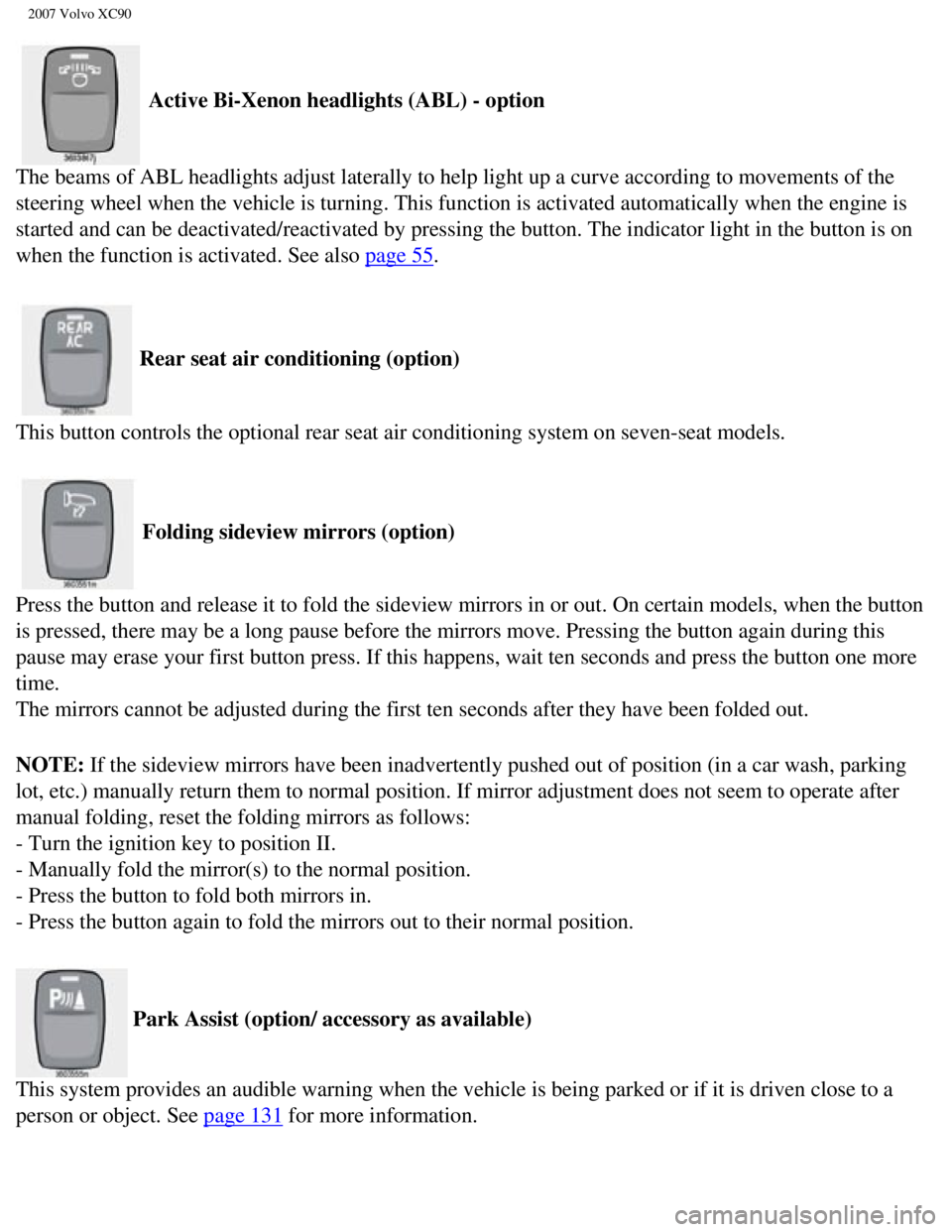
2007 Volvo XC90
Active Bi-Xenon headlights (ABL) - option
The beams of ABL headlights adjust laterally to help light up a curve ac\
cording to movements of the
steering wheel when the vehicle is turning. This function is activated a\
utomatically when the engine is
started and can be deactivated/reactivated by pressing the button. The i\
ndicator light in the button is on
when the function is activated. See also
page 55.
Rear seat air conditioning (option)
This button controls the optional rear seat air conditioning system on s\
even-seat models.
Folding sideview mirrors (option)
Press the button and release it to fold the sideview mirrors in or out. \
On certain models, when the button
is pressed, there may be a long pause before the mirrors move. Pressing \
the button again during this
pause may erase your first button press. If this happens, wait ten secon\
ds and press the button one more
time.
The mirrors cannot be adjusted during the first ten seconds after they h\
ave been folded out.
NOTE: If the sideview mirrors have been inadvertently pushed out of position \
(in a car wash, parking
lot, etc.) manually return them to normal position. If mirror adjustmen\
t does not seem to operate after
manual folding, reset the folding mirrors as follows:
- Turn the ignition key to position II.
- Manually fold the mirror(s) to the normal position.
- Press the button to fold both mirrors in.
- Press the button again to fold the mirrors out to their normal positio\
n.
Park Assist (option/ accessory as available)
This system provides an audible warning when the vehicle is being parked\
or if it is driven close to a
person or object. See
page 131 for more information.
file:///K|/ownersdocs/2007/2007_XC90/07xc90_02.htm (11 of 40)12/30/200\
6 5:53:37 PM
Page 69 of 268
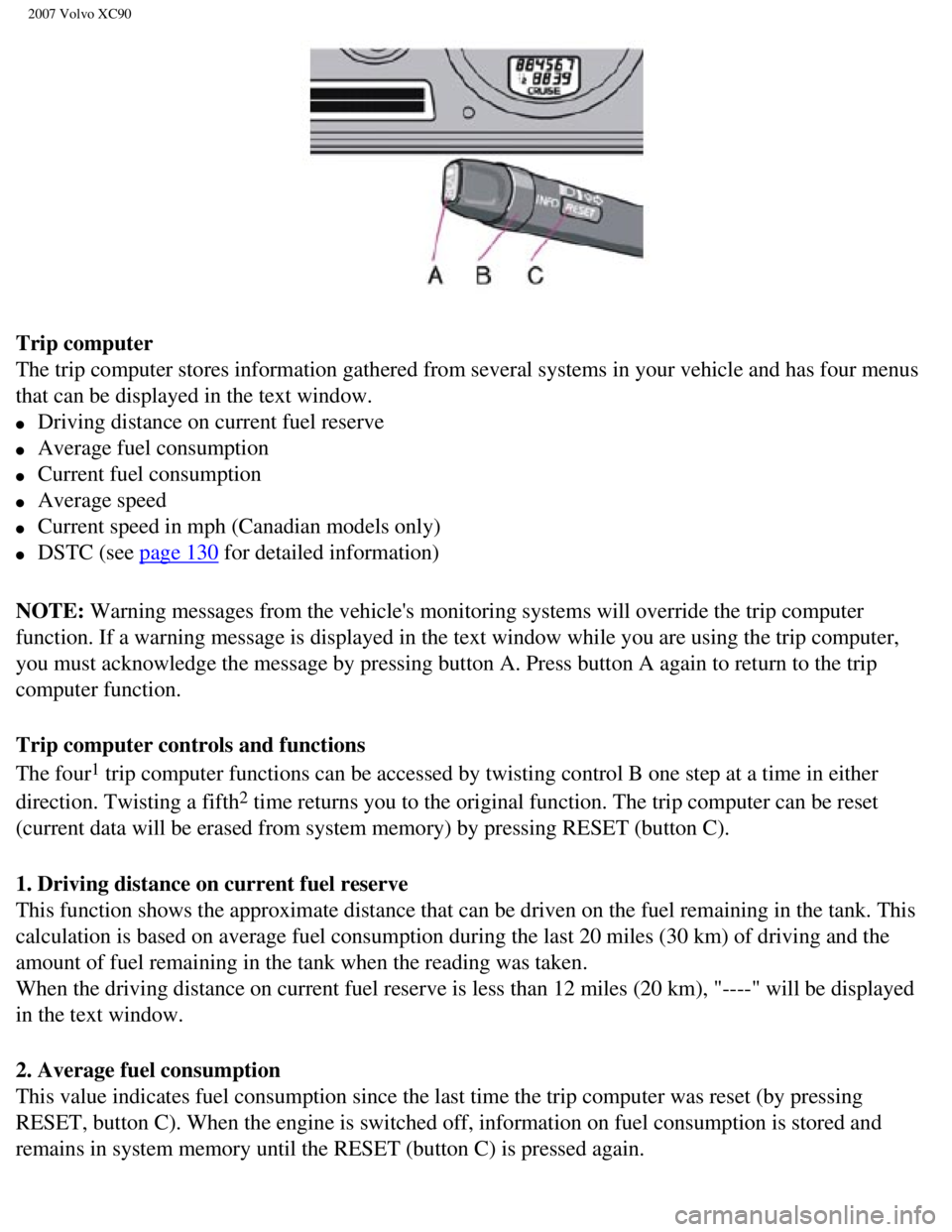
2007 Volvo XC90
Trip computer
The trip computer stores information gathered from several systems in yo\
ur vehicle and has four menus
that can be displayed in the text window.
l Driving distance on current fuel reserve
l Average fuel consumption
l Current fuel consumption
l Average speed
l Current speed in mph (Canadian models only)
l DSTC (see page 130 for detailed information)
NOTE: Warning messages from the vehicle's monitoring systems will override th\
e trip computer
function. If a warning message is displayed in the text window while you\
are using the trip computer,
you must acknowledge the message by pressing button A. Press button A ag\
ain to return to the trip
computer function.
Trip computer controls and functions
The four
1 trip computer functions can be accessed by twisting control B one step \
at a time in either
direction. Twisting a fifth
2 time returns you to the original function. The trip computer can be res\
et
(current data will be erased from system memory) by pressing RESET (b\
utton C).
1. Driving distance on current fuel reserve
This function shows the approximate distance that can be driven on the f\
uel remaining in the tank. This
calculation is based on average fuel consumption during the last 20 mile\
s (30 km) of driving and the
amount of fuel remaining in the tank when the reading was taken.
When the driving distance on current fuel reserve is less than 12 miles \
(20 km), "----" will be displayed
in the text window.
2. Average fuel consumption
This value indicates fuel consumption since the last time the trip compu\
ter was reset (by pressing
RESET, button C). When the engine is switched off, information on fuel \
consumption is stored and
remains in system memory until the RESET (button C) is pressed again.
file:///K|/ownersdocs/2007/2007_XC90/07xc90_02.htm (23 of 40)12/30/200\
6 5:53:37 PM
Page 70 of 268
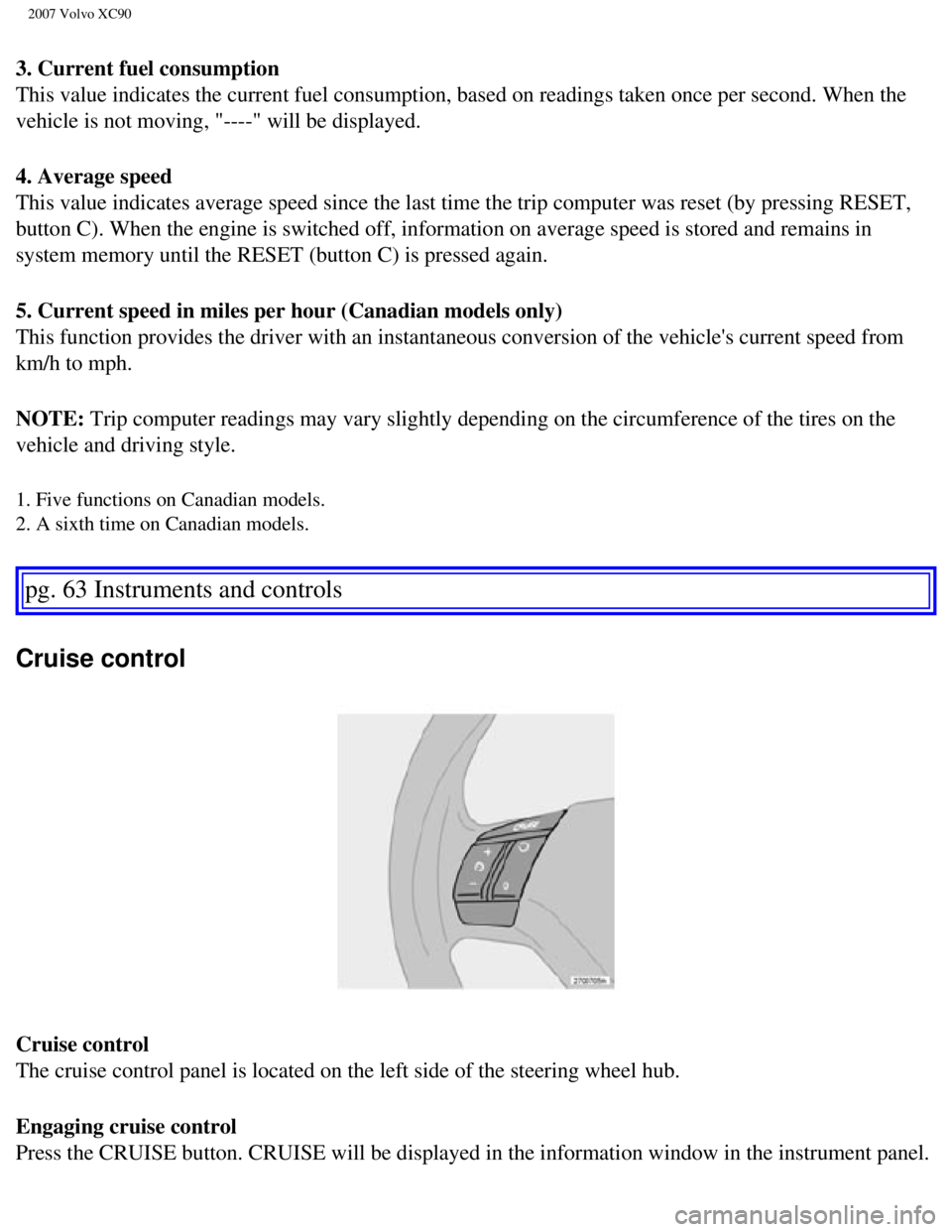
2007 Volvo XC90
3. Current fuel consumption
This value indicates the current fuel consumption, based on readings tak\
en once per second. When the
vehicle is not moving, "----" will be displayed.
4. Average speed
This value indicates average speed since the last time the trip computer\
was reset (by pressing RESET,
button C). When the engine is switched off, information on average spee\
d is stored and remains in
system memory until the RESET (button C) is pressed again.
5. Current speed in miles per hour (Canadian models only)
This function provides the driver with an instantaneous conversion of th\
e vehicle's current speed from
km/h to mph.
NOTE: Trip computer readings may vary slightly depending on the circumference\
of the tires on the
vehicle and driving style.
1. Five functions on Canadian models.
2. A sixth time on Canadian models.
pg. 63 Instruments and controls
Cruise control
Cruise control
The cruise control panel is located on the left side of the steering whe\
el hub.
Engaging cruise control
Press the CRUISE button. CRUISE will be displayed in the information win\
dow in the instrument panel.
file:///K|/ownersdocs/2007/2007_XC90/07xc90_02.htm (24 of 40)12/30/200\
6 5:53:37 PM
Page 89 of 268
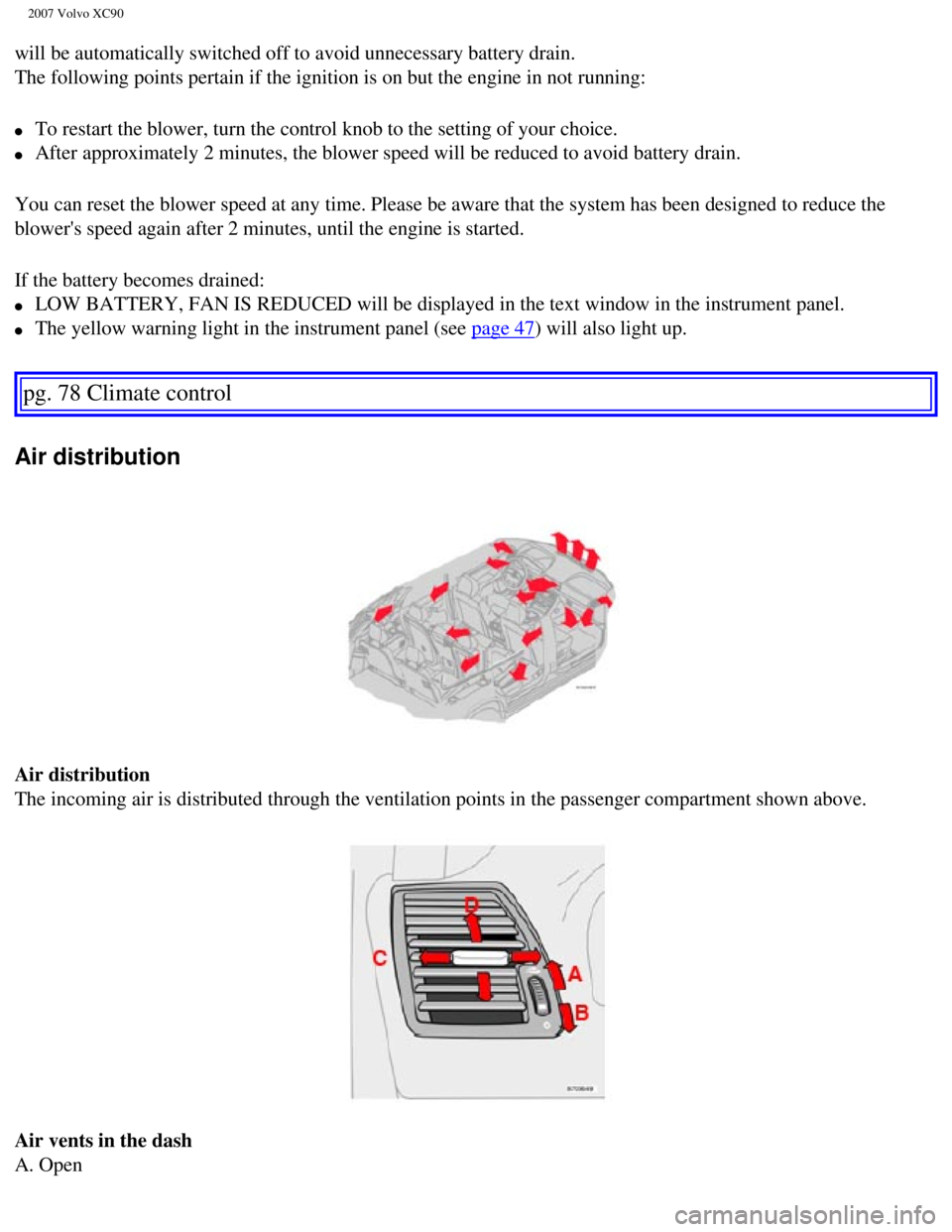
2007 Volvo XC90
will be automatically switched off to avoid unnecessary battery drain.
The following points pertain if the ignition is on but the engine in not\
running:
l To restart the blower, turn the control knob to the setting of your choi\
ce.
l After approximately 2 minutes, the blower speed will be reduced to avoid\
battery drain.
You can reset the blower speed at any time. Please be aware that the sys\
tem has been designed to reduce the
blower's speed again after 2 minutes, until the engine is started.
If the battery becomes drained:
l LOW BATTERY, FAN IS REDUCED will be displayed in the text window in the \
instrument panel.
l The yellow warning light in the instrument panel (see page 47) will also light up.
pg. 78 Climate control
Air distribution
Air distribution
The incoming air is distributed through the ventilation points in the pa\
ssenger compartment shown above.
Air vents in the dash
A. Open
file:///K|/ownersdocs/2007/2007_XC90/07xc90_03.htm (3 of 8)12/30/2006 \
5:53:38 PM
Page 99 of 268
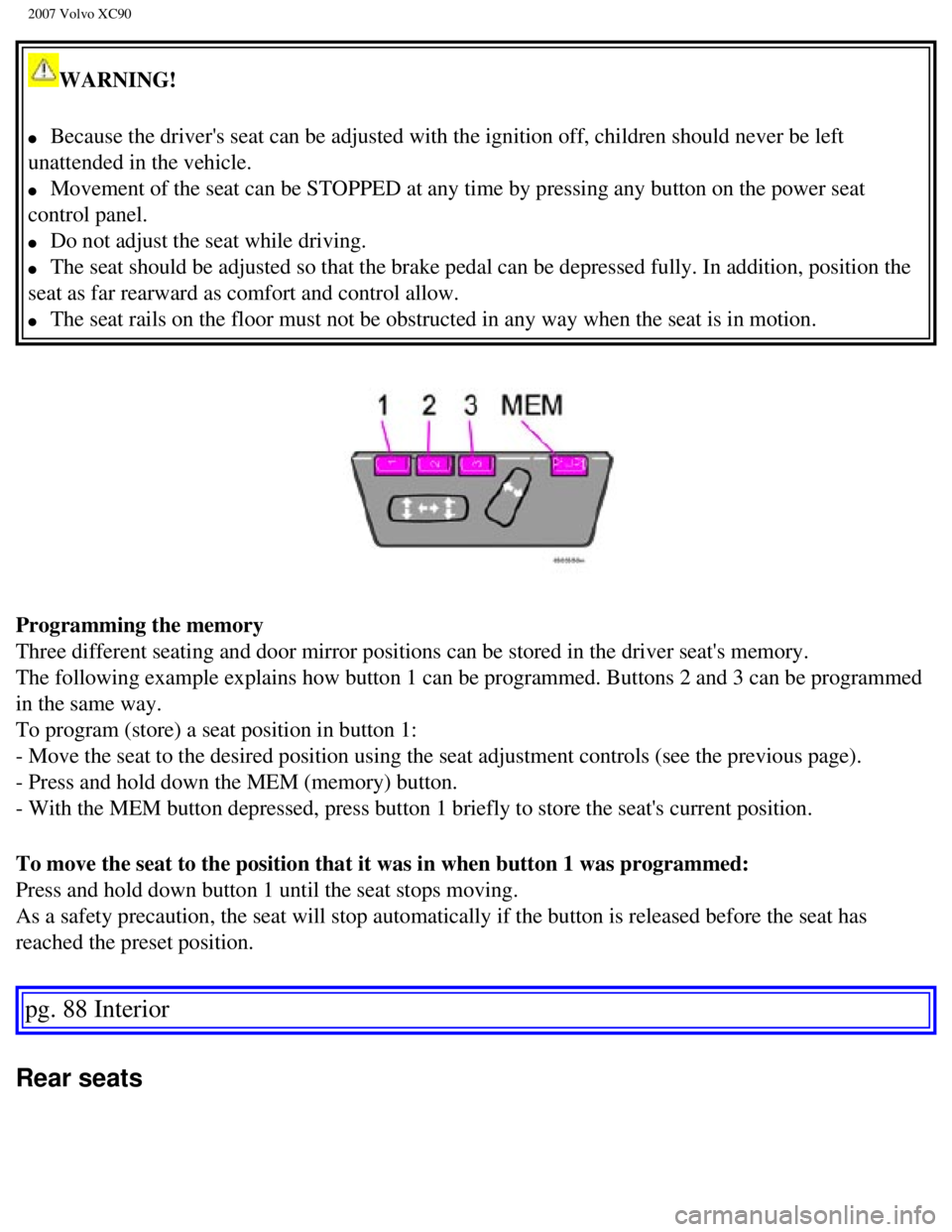
2007 Volvo XC90
WARNING!
l Because the driver's seat can be adjusted with the ignition off, childre\
n should never be left
unattended in the vehicle.
l Movement of the seat can be STOPPED at any time by pressing any button o\
n the power seat
control panel.
l Do not adjust the seat while driving.
l The seat should be adjusted so that the brake pedal can be depressed ful\
ly. In addition, position the
seat as far rearward as comfort and control allow.
l The seat rails on the floor must not be obstructed in any way when the s\
eat is in motion.
Programming the memory
Three different seating and door mirror positions can be stored in the d\
river seat's memory.
The following example explains how button 1 can be programmed. Buttons 2\
and 3 can be programmed
in the same way.
To program (store) a seat position in button 1:
- Move the seat to the desired position using the seat adjustment contro\
ls (see the previous page).
- Press and hold down the MEM (memory) button.
- With the MEM button depressed, press button 1 briefly to store the sea\
t's current position.
To move the seat to the position that it was in when button 1 was progra\
mmed:
Press and hold down button 1 until the seat stops moving.
As a safety precaution, the seat will stop automatically if the button i\
s released before the seat has
reached the preset position.
pg. 88 Interior
Rear seats
file:///K|/ownersdocs/2007/2007_XC90/07xc90_04.htm (5 of 23)12/30/2006\
5:53:40 PM
Page 140 of 268
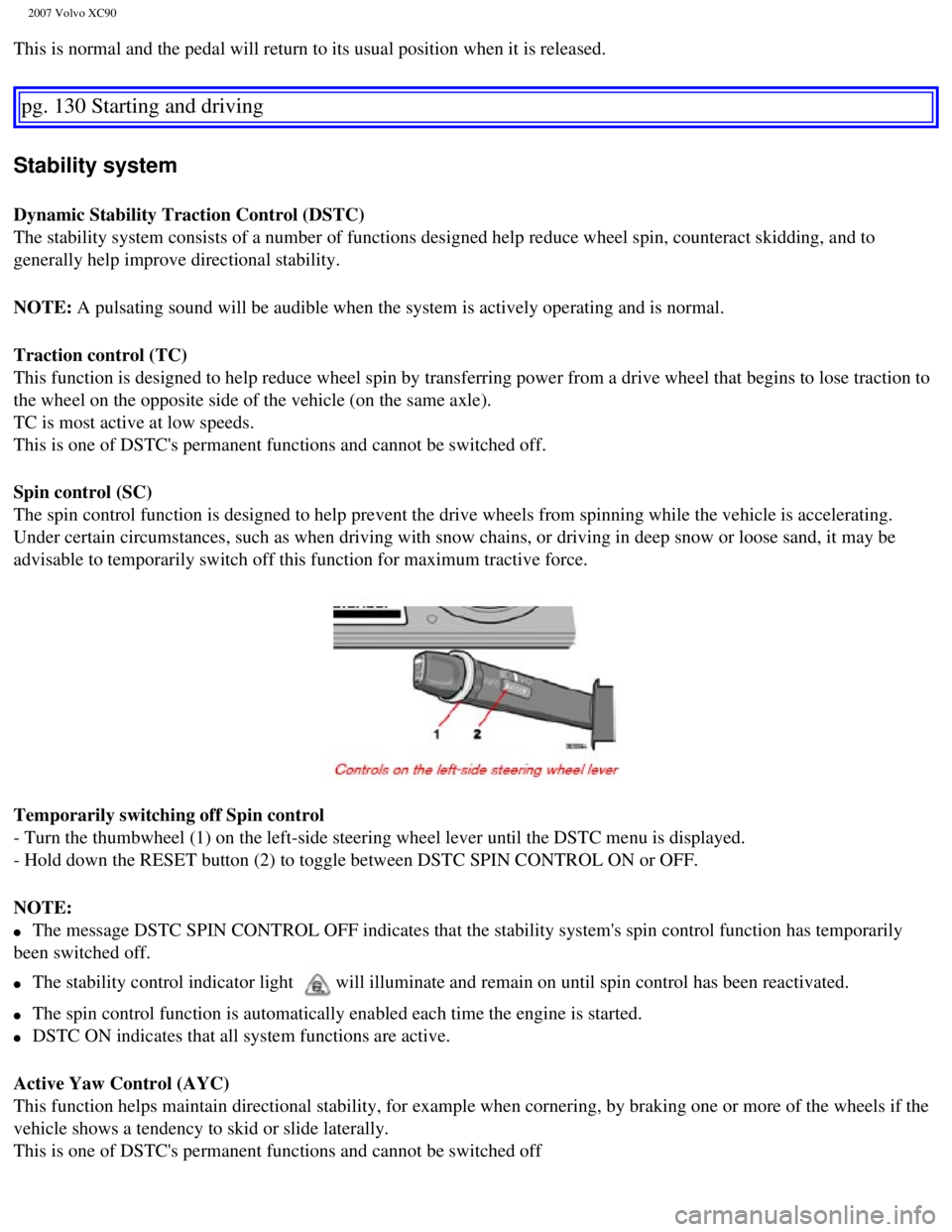
2007 Volvo XC90
This is normal and the pedal will return to its usual position when it i\
s released.
pg. 130 Starting and driving
Stability system
Dynamic Stability Traction Control (DSTC)
The stability system consists of a number of functions designed help red\
uce wheel spin, counteract skidding, and to
generally help improve directional stability.
NOTE: A pulsating sound will be audible when the system is actively operating\
and is normal.
Traction control (TC)
This function is designed to help reduce wheel spin by transferring powe\
r from a drive wheel that begins to lose traction to
the wheel on the opposite side of the vehicle (on the same axle).
TC is most active at low speeds.
This is one of DSTC's permanent functions and cannot be switched off.
Spin control (SC)
The spin control function is designed to help prevent the drive wheels f\
rom spinning while the vehicle is accelerating.
Under certain circumstances, such as when driving with snow chains, or d\
riving in deep snow or loose sand, it may be
advisable to temporarily switch off this function for maximum tractive f\
orce.
Temporarily switching off Spin control
- Turn the thumbwheel (1) on the left-side steering wheel lever until \
the DSTC menu is displayed.
- Hold down the RESET button (2) to toggle between DSTC SPIN CONTROL O\
N or OFF.
NOTE:
l The message DSTC SPIN CONTROL OFF indicates that the stability system's \
spin control function has temporarily
been switched off.
l The stability control indicator light will illuminate and remain on until spin control has been reactivated.
l The spin control function is automatically enabled each time the engine \
is started.
l DSTC ON indicates that all system functions are active.
Active Yaw Control (AYC)
This function helps maintain directional stability, for example when cor\
nering, by braking one or more of the wheels if the
vehicle shows a tendency to skid or slide laterally.
This is one of DSTC's permanent functions and cannot be switched off
file:///K|/ownersdocs/2007/2007_XC90/07xc90_06.htm (16 of 32)12/30/200\
6 5:53:44 PM
Page 165 of 268

2007 Volvo XC90
- Drive the vehicle for several minutes at a speed of 20 mph (30 km/h)\
or faster.
This will erase the warning text and the warning light will go out.
WARNING!
Incorrect inflation pressure could lead to tire failure, resulting in a \
loss of control of the
vehicle.
Changing wheels with TPMS
Please note the following when changing or replacing the factory install\
ed TPMS wheels/ tires on the
vehicle:
l Only the factory-mounted wheels are equipped with TPMS sensors in the va\
lves.
l If the vehicle is equipped with a temporary spare tire, this tire does n\
ot have a TPMS sensor.
l If wheels without TPMS sensors are mounted on the vehicle, TIRE PRESS SY\
ST SERVICE
REQUIRED will be displayed each time the vehicle is driven above 25 mph \
(40 km/h) for 10 minutes or
more.
l Once TPMS sensors are properly installed, the warning message should not\
reappear.
l Volvo recommends that TPMS sensors be fitted on all wheels used on the v\
ehicle. Volvo does not
recommend moving sensors back and forth between sets of wheels.
CAUTION!
When inflating tires with TPMS valves, press the pump's mouthpiece strai\
ght onto the valve to help
avoid bending or otherwise damaging the valve.
Adjusting (recalibrating) TPMS
1
TPMS can be adjusted, or recalibrated, in order to help adapt the system\
to different inflation pressures,
for example when transporting heavy loads. To do so:
- Switch off the engine.
- Inflate the tires to the desired pressure.
- Turn the ignition key to position I or II.
- Turn the thumbwheel on the left steering wheel lever until the text TI\
RE PRESSURE CALIBRATION
is displayed.
- Press in and hold the Reset button (see the illustration on
page 50) until TIRE PRESSURE
CALIBRATED is displayed. This completes the procedure.
NOTE: TPMS should be recalibrated each time tire inflation pressure is change\
d.
file:///K|/ownersdocs/2007/2007_XC90/07xc90_07.htm (9 of 23)12/30/2006\
5:53:47 PM